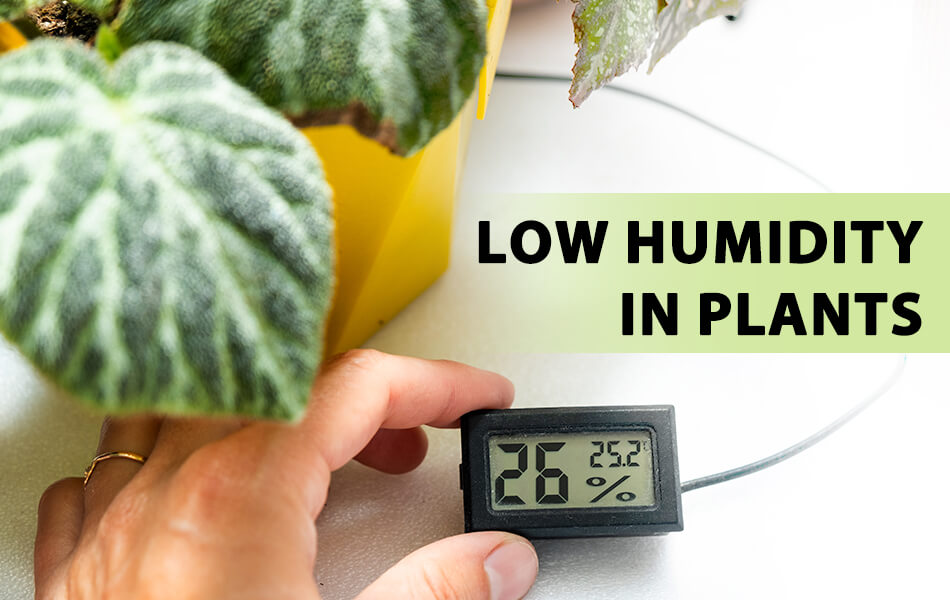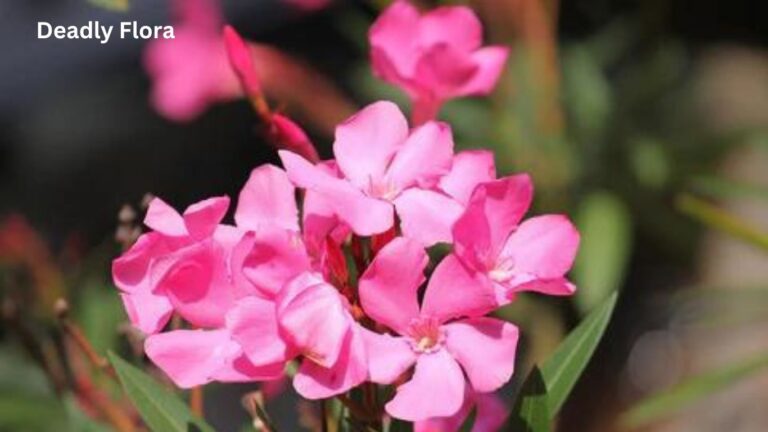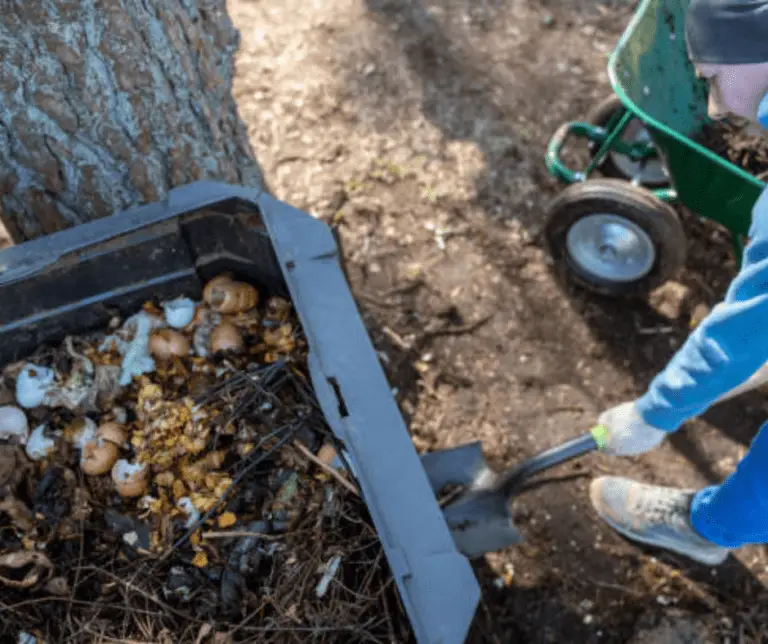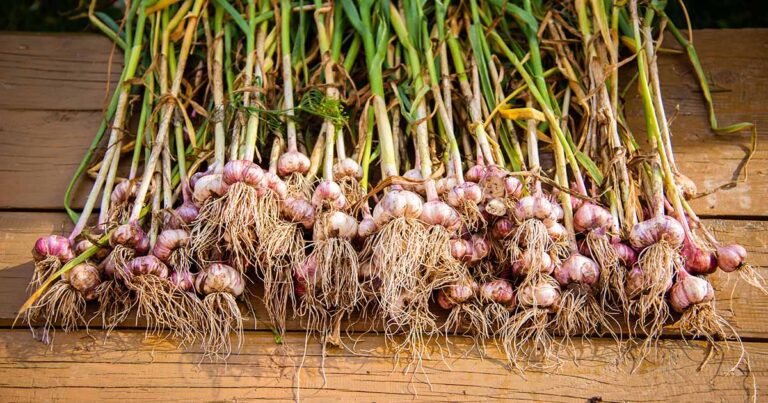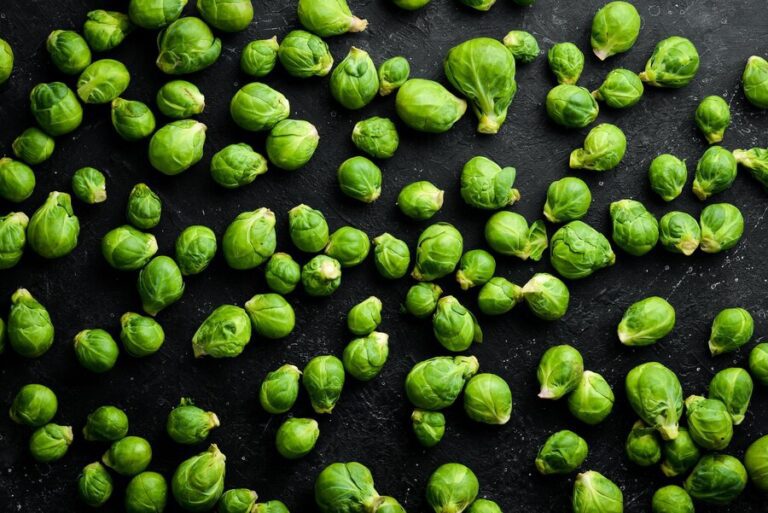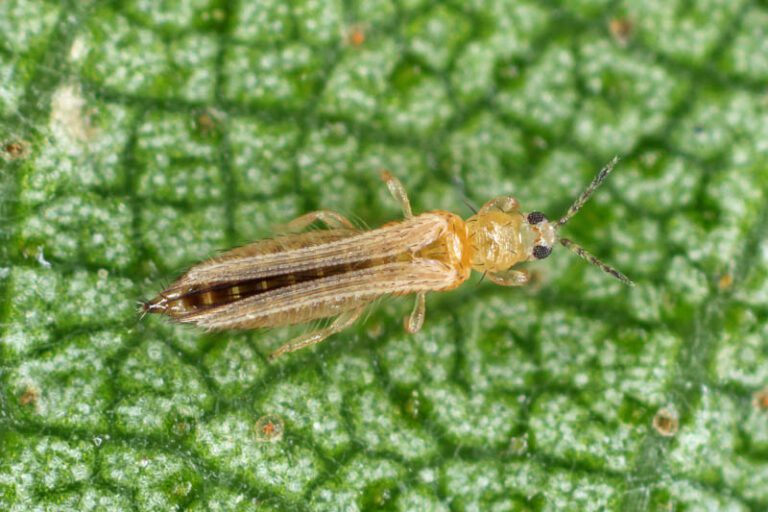Low Humidity in Plants: What It Indicates, What Causes It, and How to Remedy It
Did you know that your indoor plants might be trying to tell you something with their droopy leaves? It could be a case of low humidity! But fear not, as we dive into the fascinating world of plant care, we’ll uncover what low humidity indicates, what causes it, and most importantly, how to fix it. From the serene succulents on your windowsill to the majestic monstera in your living room, understanding their needs is crucial for their well-being.
So, let’s embark on this green journey together, armed with knowledge and a sprinkle of humor, to ensure our leafy friends thrive in every environment. Let’s turn those sad leaves into happy, flourishing foliage!
Table of Contents
Common Symptoms of Low Humidity in Plants
Low humidity can wreak havoc on plants, as they rely on a certain level of moisture in the air to thrive.

- Wilting Leaves and Foliage: Low humidity leads to accelerated water loss through transpiration, surpassing the plants’ ability to replenish it via root absorption. Consequently, leaves may appear limp, curl, or droop due to dehydration. In severe cases, leaf edges may brown and become brittle.
- Increased Pest Infestations: Dry air stresses and weakens plants, rendering them more susceptible to pest attacks. Common pests like spider mites, aphids, and whiteflies thrive in low humidity conditions and can rapidly multiply, exacerbating the plants’ condition. Moreover, diminished humidity compromises the plants’ natural defense mechanisms, hindering their ability to fend off pests and diseases effectively.
Recognizing these symptoms is crucial for plant enthusiasts, as it allows them to take immediate action in restoring the optimal humidity levels and saving their beloved plants from further harm.
The Impact of Low Humidity on Plant Health and Growth
Low humidity can have a significant impact on the health and growth of plants.

Dehydration and Wilting:
- In low humidity conditions, plants struggle to absorb water through their roots, leading to dehydration.
- Symptoms include wilting, drooping leaves, and overall poor health due to insufficient hydration.
Hindered Transpiration:
- Low humidity hampers the transpiration process, where plants release excess water through their leaves.
- Transpiration regulates temperature and helps keep the plant hydrated, vital for its overall health.
Stressed Growth:
- Inadequate humidity inhibits plants from effectively cooling themselves, resulting in stressed and weakened growth.
Increased Pest and Disease Risk:
- Low humidity creates an environment conducive to pests and diseases, further compromising plant health.
- Pests such as spider mites, aphids, and whiteflies thrive in these conditions, exacerbating the plant’s challenges.
To ensure optimal plant health:
- Monitor humidity levels and aim for appropriate ranges.
- Use methods like misting, pebble trays, or humidifiers to increase humidity indoors.
- Grouping plants together can create a microclimate with higher humidity.
- Regularly inspect plants for signs of pests or diseases and take appropriate measures to control them.
Identifying the Factors that Contribute to Low Humidity in Indoor Environments
Factors that contribute to low humidity in indoor environments can vary, but understanding these factors is crucial in maintaining healthy plant growth.
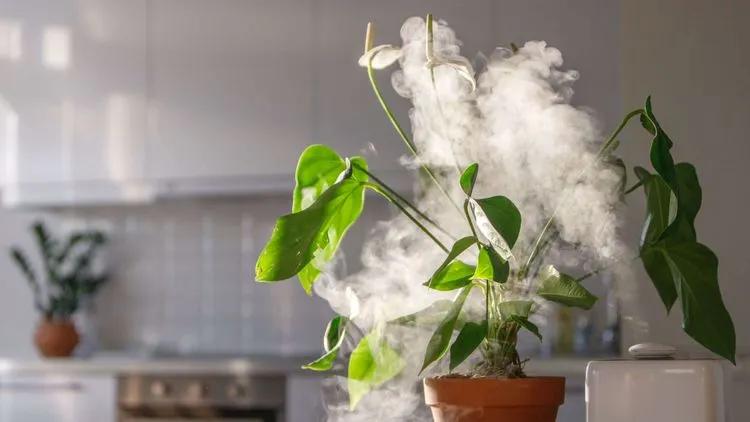
- Improve Ventilation:
- Open Windows and Doors: Regularly open windows and doors to allow fresh air to circulate. This helps prevent moisture buildup and maintains a healthy humidity level.
- Use Exhaust Fans: In areas like bathrooms, kitchens, and laundry rooms, use exhaust fans to remove humid air. Make sure these fans vent to the outside.
- Install Air Vents: Properly placed air vents can enhance airflow throughout the house. Consider installing vents in areas with poor circulation.
- Position Furniture Wisely: Avoid blocking air vents or obstructing airflow with furniture.
- Monitor Heating Systems:
- Humidifiers: Use humidifiers during colder months to add moisture to the air. Place them strategically in rooms where you spend the most time.
- Adjust Heating Settings: Lower the temperature on your heating system to reduce its drying effect. If possible, use a programmable thermostat to maintain consistent indoor conditions.
- Avoid Overheating: Excessive heat can lead to faster evaporation. Keep your home comfortably warm without overheating.
- Manage Cooling Systems:
- Humidity Settings: If you have air conditioning, check if it has a humidity control setting. Set it to maintain an optimal humidity level.
- Regular Maintenance: Clean or replace air filters in your cooling system. Dirty filters can hinder airflow and affect humidity levels.
- Use Fans: Ceiling fans or portable fans can help distribute cool air evenly and prevent stagnant pockets of dry air.
- Seal Leaks and Cracks:
- Inspect doors, windows, and walls for gaps or cracks. Seal them properly to prevent air leaks and maintain consistent humidity.
- Add Indoor Plants:
- Houseplants release moisture through a process called transpiration. Having indoor plants can naturally increase humidity levels.
- Use Water Sources Strategically:
- Place shallow trays of water near heat sources (such as radiators or stoves). As the water evaporates, it adds humidity to the air.
- Consider using a decorative indoor fountain or a tabletop water feature.
- Monitor Humidity Levels:
- Use a hygrometer to measure indoor humidity. Aim for a range of 40% to 60% relative humidity.
- Adjust your efforts based on the readings. If humidity is too low, take additional steps to increase it.
Identifying these factors that contribute to low humidity in indoor environments is crucial for plant enthusiasts, as it allows them to take the necessary steps to counteract the effects. By ensuring proper ventilation and monitoring heating and cooling systems, individuals can create a more favorable environment for their indoor plants.
The Broan-NuTone 688 exhaust fan proved to be a reliable addition to my bathroom. Its efficient ventilation swiftly removes steam and odors, creating a more pleasant environment after showers. Despite its basic design, the fan operates quietly, ensuring minimal disruption. Installation was straightforward, and its durable construction gives me confidence in its longevity. While it lacks advanced features like humidity sensors, its affordable price and effective performance make it a practical choice for improving air quality in any home.
- Efficient Ventilation: Effectively removes steam, odors, and moisture from your bathroom or utility space, improving air quality.
- Easy Installation: Simple to install with basic tools, making it a convenient upgrade for your home.
- Quiet Operation: Runs quietly, ensuring minimal disruption while providing powerful ventilation.
- Durable Construction: Made of high-quality plastic, ensuring longevity and resistance to corrosion in damp environments.
- Versatile Design: Suitable for use in bathrooms, laundry rooms, and other areas where ventilation is needed.
- Affordable Price: Offers excellent value for money compared to other exhaust fan options on the market.
- Basic Design: Some users may find the design to be plain or lacking in aesthetic appeal.
- Limited Features: Does not include advanced features such as humidity sensors or built-in lights, which may be desired by some consumers.
- Size Consideration: The 50 CFM airflow may not be sufficient for larger bathrooms or spaces, requiring multiple units for effective ventilation.
- Plastic Construction: While durable, the plastic material may not be as robust as metal alternatives.
- Wiring Requirements: Requires access to electrical wiring for installation, which may be challenging for some homeowners without prior experience.
- No Timer Function: Lacks a timer function for automated operation, requiring manual control.
Natural Causes of Low Humidity in Plants
Low humidity in plants can be caused by a variety of natural factors. One common cause is dry air due to low moisture levels in the surrounding environment. This can occur in arid regions or during periods of drought. When the air is dry, plants lose water more quickly through transpiration, leading to decreased overall humidity levels.
Another natural cause of low humidity in plants is excessive heat. High temperatures can increase the rate of evaporation, resulting in drier air and lower humidity levels. Additionally, wind can also contribute to low humidity in plants. Strong winds can increase the rate of evaporation from plant leaves, causing the surrounding air to become drier.
The following table shows the natural causes of low humidity in plants:
| Natural Factor | Impact on Humidity | Quantitative Impact |
|---|---|---|
| 1. High Temperature | – Increases evaporation from soil and plant surfaces. | – Temperature increase of 10°F can reduce humidity by 10%. |
| 2. Windy Conditions | – Accelerates moisture evaporation from leaves and soil. | – Wind speeds above 10 mph can significantly lower humidity. |
| 3. Sun Exposure | – Direct sunlight promotes water loss through transpiration. | – Intense sunlight can reduce humidity by 5-10%. |
| 4. Low Soil Moisture | – Insufficient soil moisture limits humidity around plants. | – Soil moisture levels below 30% contribute to lower humidity. |
| 5. Drought Stress | – Plants experiencing drought stress release more water vapor. | – Severe drought stress can reduce humidity by 15-20%. |
| 6. Arid Climate | – Naturally low humidity in arid regions affects local conditions. | – Regions with average humidity below 30% experience persistent low humidity. |
The Role of Climate and Seasonal Changes in Humidity Levels
Climate and seasonal changes play a crucial role in determining the humidity levels in our environment, which in turn have a direct impact on plant health.
- Different climatic regions exhibit varying levels of humidity throughout the year.
- For example, tropical regions tend to have higher humidity levels due to their proximity to the equator, while arid regions experience lower humidity levels due to the presence of dry desert air.
- Similarly, seasonal changes also affect humidity levels, with summer months generally being more humid and winter months being drier.
- These fluctuations in humidity can significantly affect plants, as they have specific moisture requirements for optimal growth and development.
- High humidity levels can create a favorable environment for fungal diseases, including powdery mildew and leaf spot, as well as attract pests such as aphids and spider mites.
- On the other hand, low humidity levels can lead to excessive moisture loss from plant leaves, causing wilting and stunted growth.
- Understanding the role of climate and seasonal changes in humidity levels is essential for gardeners and plant enthusiasts to make informed decisions about plant care and create suitable environments for their plants to thrive.
Understanding the Effects of Artificial Heating and Cooling on Plant Humidity
Artificial heating and cooling systems play a significant role in maintaining the desired temperature indoors. However, it is important to understand the effects these systems can have on plant humidity.
- Heating Systems and Plant Humidity:
- Use Humidifiers: Place humidifiers strategically in rooms with plants. These devices add moisture to the air, counteracting the drying effect of heating systems.
- Monitor Indoor Humidity: Regularly measure indoor humidity levels using a hygrometer. Aim for a range of 40% to 60% relative humidity.
- Adjust Heating Settings: Lower the temperature on your heating system to reduce its drying effect. Consider using a programmable thermostat to maintain consistent indoor conditions.
- Avoid Overheating: Excessive heat can lead to faster evaporation. Keep your home comfortably warm without overheating.
- Cooling Systems and Plant Humidity:
- Humidity Control Settings: If you have air conditioning, check if it has a humidity control setting. Set it to maintain an optimal humidity level.
- Regular Maintenance: Clean or replace air filters in your cooling system. Dirty filters can hinder airflow and affect humidity levels.
- Strategic Cooling: Use air conditioning judiciously. Consider cooling specific areas rather than the entire house to minimize the impact on plants.
- Fans and Air Circulation: Use fans to improve air circulation. Proper airflow helps distribute cool air without excessively drying out the environment.
- Plant-Specific Measures:
- Group Plants: Arrange plants together to create a microclimate with higher humidity. Plants release moisture through transpiration, benefiting neighboring plants.
- Misting: Regularly mist your plants with water. This provides localized humidity and keeps foliage hydrated.
- Trays of Water: Place shallow trays of water near heat sources (such as radiators). As the water evaporates, it adds humidity to the air.
- Indoor Fountains or Water Features: Consider decorative indoor fountains or tabletop water features. They enhance humidity while adding aesthetic appeal.
- Seal Leaks and Cracks:
- Inspect doors, windows, and walls for gaps or cracks. Properly seal them to prevent air leaks and maintain consistent humidity.
- Plant Selection:
- Choose plants that tolerate lower humidity levels. Some varieties are more resilient to dry conditions.
- Research specific plant requirements and adapt your indoor environment accordingly.
Remember that maintaining suitable humidity levels benefits both humans and plants. By implementing these steps, you can create a comfortable living space while ensuring optimal plant health! 😊
The ThermoPro Hygrometer exceeded my expectations with its accuracy and ease of use. Its clear display made it effortless to monitor indoor humidity and temperature levels at a glance. Whether placed on a tabletop or mounted on the wall, it seamlessly integrated into my home. While lacking advanced features like connectivity and data logging, its reliable performance and long battery life make it a practical choice for anyone seeking straightforward indoor climate monitoring.
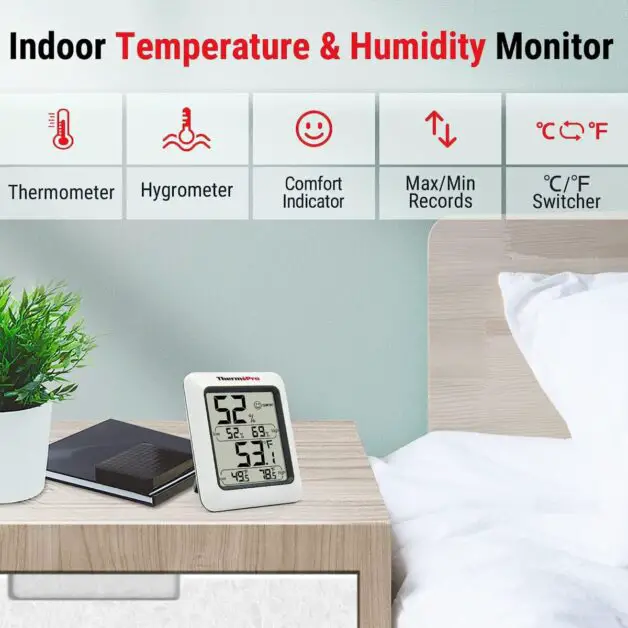
✅ Large Display: The ThermoPro hygrometer features a clear, easy-to-read display, making it convenient to check conditions at a glance.
✅ Multiple Mounting Options: Can be placed on a tabletop or mounted on a wall for versatile placement in any room.
✅ Humidity Level Indicator: Includes an indicator to show whether the humidity level is too low, optimal, or too high, aiding in humidity management.
✅ Battery Life: Offers long battery life, minimizing the need for frequent battery replacements.
✅ Compact Size: Its compact design takes up minimal space, ideal for use in various indoor environments.
❌ No Connectivity: Lacks smart connectivity features, meaning it cannot be accessed remotely or integrated with smart home systems.
❌ No Data Logging: Does not offer the ability to log historical data, which may be desired for tracking trends over time.
❌ Manual Calibration: Requires manual calibration to ensure accuracy, which may be inconvenient for some users.
❌ Display Brightness: The display brightness may not be adjustable, potentially causing glare in certain lighting conditions.
❌ Plastic Construction: The hygrometer’s construction is primarily plastic, which may not be as durable as metal alternatives.
Proper Watering Techniques to Increase Humidity for Plants
Proper watering techniques are essential for maintaining optimal humidity levels for plants. When it comes to increasing humidity, the way you water your plants can make a big difference.

Water plants thoroughly to ensure moisture reaches the roots, creating a moist environment in the soil.
This technique helps increase humidity around the plants, promoting healthier growth.
Be cautious of over-watering, as excess moisture can lead to fungal growth and root rot, harming the plants.
Check soil moisture levels regularly before watering to strike the right balance.
Check soil moisture by inserting your finger about an inch into the soil.
If the soil feels dry, it’s time to water the plants.
If the soil feels moist, wait a little longer before watering to prevent over-watering and maintain optimal soil conditions.
By following these proper watering techniques, you can effectively increase humidity for your plants, promoting their health and growth.
Utilizing Humidifiers and Mist Systems to Improve Plant Humidity
Humidifiers and mist systems are excellent tools for increasing plant humidity in indoor environments.
Install a Humidifier:
- Choose a humidifier suitable for your plants’ needs, considering factors like size, type, and capacity.
- Place the humidifier near your plants to release a fine mist of water into the air, raising humidity levels.
- This simple and effective method helps create the humid conditions ideal for plants that thrive in high humidity environments.
Select the Right Type of Humidifier:
- Explore various types of humidifiers available, such as ultrasonic, evaporative, and steam vaporizers.
- Assess the advantages and disadvantages of each type to determine which suits your needs and plant requirements best.
Consider Mist Systems:
- Alternatively, opt for mist systems that emit a fine mist directly onto the plants’ foliage.
- These systems not only increase humidity but also aid in keeping leaves clean and free from dust.
Ensure Proper Usage:
- Avoid excessive or prolonged misting, as it can lead to fungal diseases due to excess moisture.
- Maintain a balance to provide sufficient humidity without risking plant health.
Incorporating Plant Grouping and Terrariums to Enhance Humidity Levels
When it comes to enhancing humidity levels for plants, incorporating plant grouping and terrariums can be an effective strategy. Grouping plants together creates a microclimate within the cluster, where the plants can collectively increase humidity levels through transpiration. This process occurs when plants release moisture from their leaves into the surrounding air.
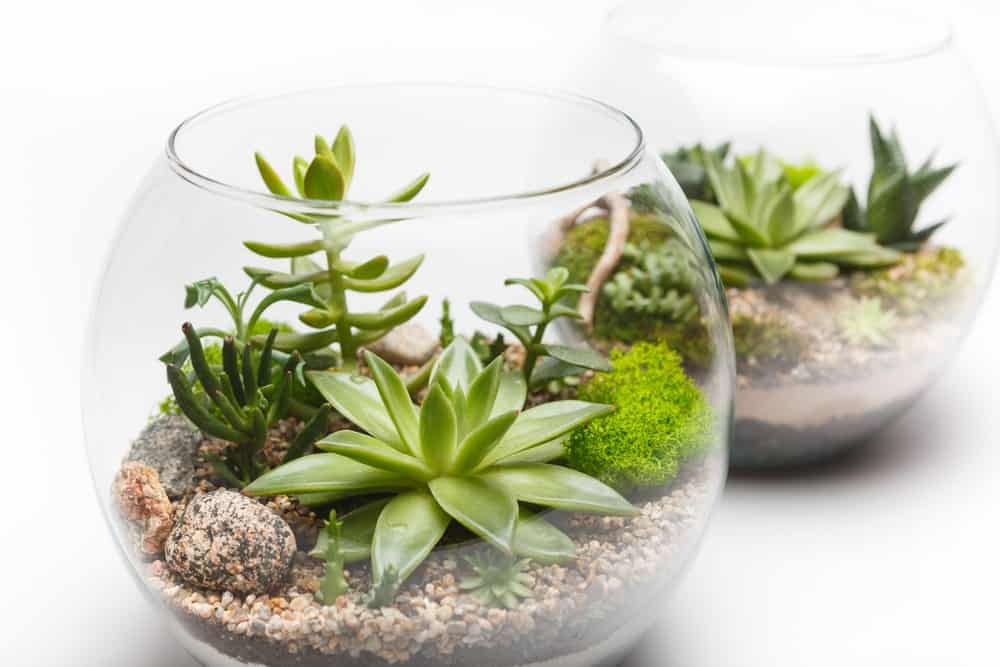
Place multiple plants in close proximity to each other to harness the combined transpiration effect.
This increases humidity levels around the plants , benefiting all members of the group.
Opt for terrariums to create an enclosed environment that traps humidity and maintains moisture.
Terrariums act as miniature greenhouses, preventing moisture evaporation and providing a stable humidity atmosphere, especially for humidity-loving plants.
Group plants with similar humidity requirements together to create specialized microclimates.
This allows for tailored environments that cater to the specific needs of different plant species, promoting optimal growth and health.
Terrariums offer protection from harsh external factors like extreme temperature fluctuations or low humidity caused by heating or air conditioning systems.
This controlled environment ensures stable conditions, particularly beneficial for indoor plants exposed to artificial heating or cooling.
By implementing plant grouping and terrariums, gardeners can not only increase humidity levels but also provide a conducive and stable environment for overall plant well-being.
By incorporating plant grouping and terrariums, gardeners can not only enhance humidity levels but also provide a more conducive and stable environment for their plants’ overall well-being.
Choosing the Right Plant Species for Low Humidity Environments
Choosing the right plant species for low humidity environments is crucial for ensuring their survival and optimal growth. Not all plants are equipped to thrive in dry conditions, so it is important to select species that have adapted to withstand these challenges.
:strip_icc()/peace-lily-spathiphyllum-wallisii-domino-bd41865a1-252ea4c0b35b43d19a41435b16a9cd01.jpg)
Choose Succulents:
- Opt for succulent, which are well-suited for low humidity environments due to their ability to store water in their thick, fleshy leaves.
- Popular varieties include echeverias, aloe vera, and sedums, known for their drought tolerance and unique textures.
Consider Cacti:
- Another suitable option for low humidity environments is cacti, renowned for their resilience in harsh desert conditions.
- Cacti store water in their stems, enabling them to survive prolonged periods of low humidity.
Select Varieties:
- Choose specific varieties of cacti such as prickly pear, barrel cactus, and Christmas cactus, known for their ability to thrive in low humidity conditions.
Enhance Indoor Gardens:
- Succulents and cacti not only tolerate low humidity but also add beauty and unique textures to indoor gardens.
- Incorporating these plants can enhance the aesthetic appeal of your indoor space while ensuring they thrive in their environment.
The following table shows the different plant species for low humidity environments:
| Plant Species | Humidity Tolerance | Watering Frequency | Sunlight Requirement | Temperature Range (°F) | Adaptability to Low Humidity |
|---|---|---|---|---|---|
| 1. Lavender | – Moderate to high tolerance. | – Low to moderate frequency. | – Full sun to partial shade. | – 60°F to 90°F | – Well-adapted to low humidity. |
| 2. Succulents (e.g., Aloe Vera) | – High tolerance. | – Infrequent watering. | – Full sun to bright light. | – 70°F to 90°F | – Thrives in arid conditions. |
| 3. Rosemary | – Moderate to high tolerance. | – Low to moderate frequency. | – Full sun to partial shade. | – 60°F to 90°F | – Well-suited to low humidity. |
| 4. Zinnias | – Moderate tolerance. | – Regular watering. | – Full sun. | – 70°F to 90°F | – Adaptable to low humidity. |
| 5. Cacti (e.g., Barrel Cactus) | – High tolerance. | – Infrequent watering. | – Full sun to bright light. | – 60°F to 100°F | – Thrives in arid environments. |
By carefully selecting plant species that are adapted to low humidity conditions, gardeners can create thriving indoor gardens that are both beautiful and resilient.
Proper Plant Placement and Location to Minimize the Effects of Low Humidity
Proper placement and location of plants is crucial in minimizing the effects of low humidity.
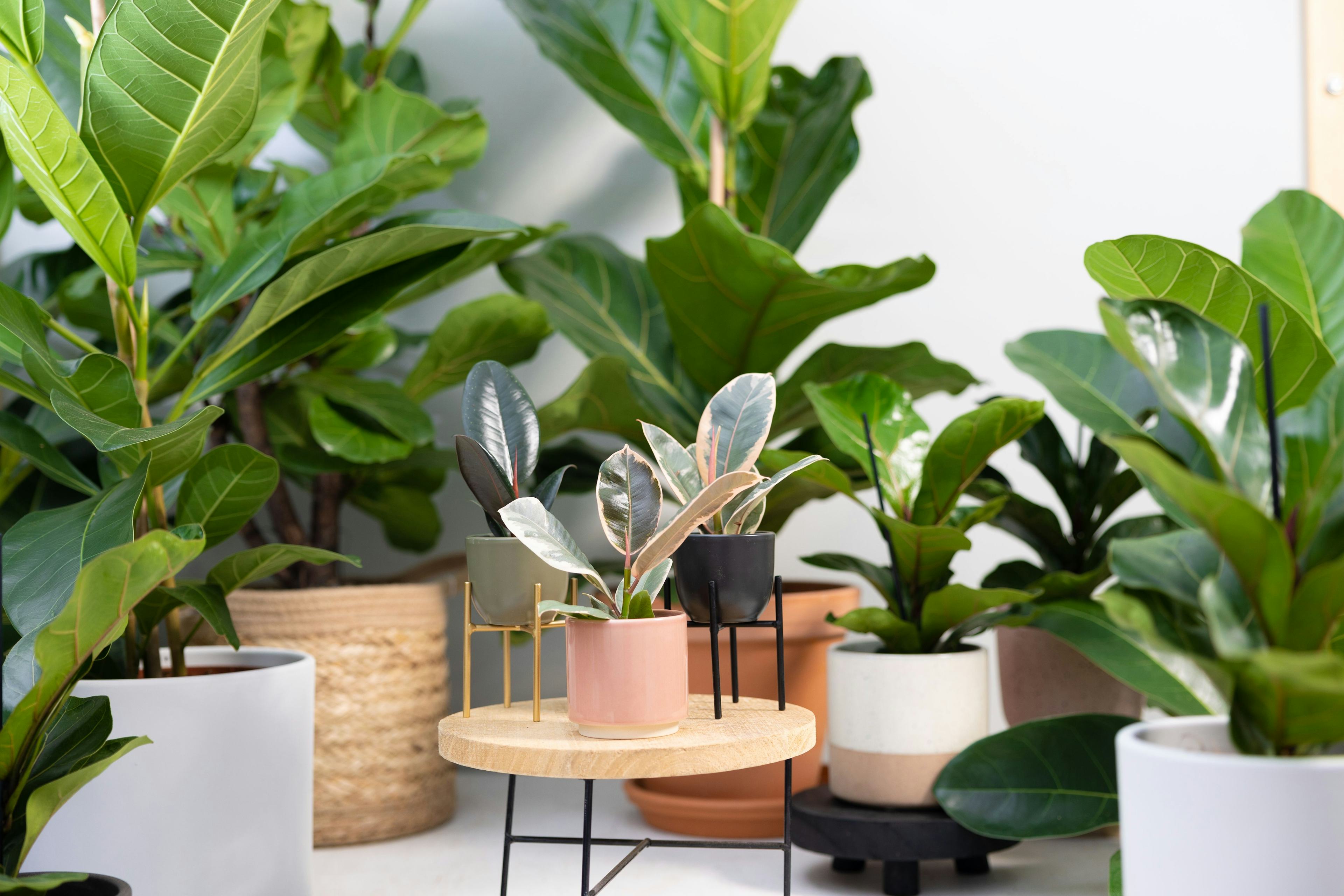
By carefully selecting the placement and location of your plants, you can create a microclimate that is more conducive to optimal humidity levels. This will help minimize the negative effects of low humidity and promote healthier growth and overall plant wellbeing.
Monitoring and Adjusting Humidity Levels for Optimal Plant Health
Monitoring and adjusting humidity levels is essential for maintaining optimal plant health. By closely monitoring the humidity levels in your indoor environment, you can ensure that your plants are receiving the appropriate moisture they need to thrive.
Use a Hygrometer:
- Utilize a hygrometer to monitor moisture levels near your plants regularly.
- Check readings to ensure humidity remains within the desired range, considering the specific needs of different plant species.
Adjusting Humidity:
- Increase humidity by misting plants regularly with water to simulate their natural environment.
- Place a humidifier near plants or create a humidity tray by filling a shallow tray with water and placing it nearby.
- The evaporation of water from the tray helps increase humidity in the surrounding air, benefiting plant health.
Maintaining the appropriate humidity levels for your plants requires regular monitoring and adjustments. By taking these measures, you can provide an optimal growing environment for your plants, promoting their health and growth.
Watch video for more information:
FAQ
Can low humidity in plants cause wilting?
Yes, low humidity can cause plants to wilt as it leads to excessive water loss through transpiration.
How Can I Identify If My Plant Is Suffering From Low Humidity?
Common symptoms of low humidity in plants include dry or crispy leaves, browning leaf tips, slowed growth, and an increase in pests or diseases.
What are some natural causes of low humidity in plants?
Natural causes of low humidity can include dry climates, indoor heating systems, and air conditioning units.
Can seasonal changes affect humidity levels for plants?
Yes, seasonal changes can impact humidity levels. For example, winter tends to have lower humidity levels due to indoor heating, while summer may have higher humidity levels.
How can artificial heating and cooling affect plant humidity?
Artificial heating and cooling systems can reduce humidity levels in indoor environments, which can negatively impact plant health.
Are there specific watering techniques to increase humidity for plants?
Yes, watering techniques such as misting the leaves or placing water-filled trays near plants can increase humidity levels.
Can using humidifiers or mist systems improve plant humidity?
Yes, utilizing humidifiers or mist systems can effectively increase humidity levels for plants.
How can plant grouping and terrariums enhance humidity levels?
Plant grouping and terrariums create a microclimate that can help retain moisture and increase humidity levels around the plants.
Are there plant species that are better suited for low humidity environments?
Yes, certain plant species, such as succulents or cacti, are more tolerant of low humidity environments.
Does the placement of plants affect humidity levels?
Yes, placing plants away from direct sources of heat or air conditioning vents can help minimize the effects of low humidity.
How can I monitor and adjust humidity levels for optimal plant health?
Using a hygrometer can help monitor humidity levels, and adjusting the placement of plants, using humidifiers, or misting can help maintain optimal humidity levels.
Can low humidity be harmful to all types of plants?
While low humidity can be detrimental to many plants, some species have naturally adapted to thrive in low humidity environments.
What are the long-term effects of low humidity on plant health and growth?
Prolonged exposure to low humidity can result in stunted growth, weakened immune systems, increased susceptibility to pests and diseases, and even plant death.
How frequently should I water my plants to maintain adequate humidity?
The watering frequency will depend on various factors such as plant species, pot size, and environmental conditions. It is best to monitor the soil moisture and water as needed.

Studied Agricultural Engineering-Plant Protection at University of California, Davis.
Head of Content writing team at Southelmontehydroponics.com

